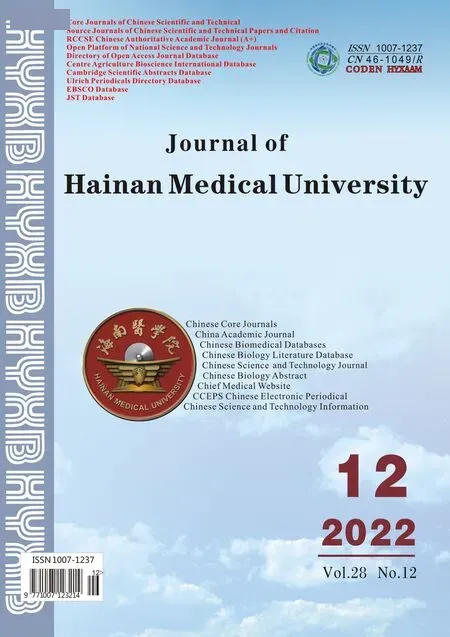Clinical study on the correlation between plasma lipopolysaccharide and the structural characteristics of coronary intravascular ultrasound plaques
Meng-Xian Hu,Gui-Xin He,✉, Dong-Mei Yuan, Wei-Bin Qin, Lin Lin, Yu-Fei Feng,Guo-Kun Zheng, Zi-Yong Jia
1. Guangxi University of Traditional Chinese Medicine, Nanning 530299, China
2. The First Affiliated Hospital of Guangxi Universityof Chinese Medicine, Nanning 530022, China
ARTICLE INFO
Article history:Received 30 May 2022 Received in revised form 9 Jun 2022 Accepted 15 Jun 2022 Available online 29 Jun 2022
Keywords:Plasma lipopolysaccharide Plaque stability Intravascular ultrasound Unstable angina
ABSTRACT Objective: To study the correlation between plasma lipopolysaccharide and coronary atherosclerotic heart disease risk factors and plaque stability. Methods: 136 patients with unstable angina pectoris who underwent coronary angiography and intravascular ultrasound were selected from the First Affiliated Hospital of Guangxi University of Traditional Chinese Medicine. According to the results of IVUS, they were divided into stable plaques (stable plaques,SP) group of 72 patients With 64 cases in the Unstable plaques (UP) group, venous blood was drawn from the two groups of patients for blood lipid and lipopolysaccharide index detection,and the general baseline data of the two groups were recorded; the structural characteristics of the intravascular ultrasound plaques in the two groups were analyzed. To study the influencing factors of unstable plaques, the correlation between lipopolysaccharide and plaque structural characteristics, and the diagnostic efficacy of unstable plaques. Results: The expression levels of cholesterol, low-density lipoprotein, and LPS in the UP group were higher than those in the SP group (P<0.05), and the high-density lipoprotein expression levels were lower than those in the SP group (P=0.035); and the intravascular ultrasound structure of the plaque was UP The lipid pool area, the ratio of lipid pool to plaque area, the plaque eccentricity index, and the maximum plaque thickness of the group were higher than those of the SP group (P<0.05),and the minimum plaque thickness was smaller than that of the SP group and the difference was statistically significant (P<0.05); LPS was positively correlated with cholesterol, lowdensity lipoprotein, lipid pool area, ratio of lipid pool to plaque area, plaque eccentricity index,and maximum plaque thickness by Pearson correlation test (P<0.05) , Is negatively correlated with high-density lipoprotein (P=0.021); LPS is a risk factor for coronary plaque stability, and HDL is a protective factor for coronary plaque stability by binary logistic regression test. The difference is statistically significant Scientific significance (P=0.049, P=0.002); LPS diagnosis of coronary atherosclerotic plaque stability ROC area under the curve (AUC) is 0.889, 95%CI is (0.805, 0.974), the best diagnosis point is 57.485 mg /L, the sensitivity is 80.60%, and the specificity is 73.70%. Conclusion: Plasma lipopolysaccharide is a risk factor of unstable plaque, which has certain diagnostic value for coronary artery plaque, and can be used as a quantitative diagnostic index of plaque vulnerability.✉Corresponding author: HE Gui-xin,Chief physician,Ph.D..
 Journal of Hainan Medical College2022年12期
Journal of Hainan Medical College2022年12期
- Journal of Hainan Medical College的其它文章
- Research progress of Cassytha filiformis L
- Research on anti-pancreatic cancer mechanism of Codonopsis codonopsis based on network pharmacology
- Risk factors for infection with multidrug-resistant organisms in diabetic foot ulcer patients: A systematic review and meta-analysis
- Correlation between NF-κB/TNF-αpathway and atrial fibrillation
- Effectiveness of Shengmai Injection on angina pectoris based on realworld propensity score method
- Construction and validation of prognostic model of hepatocellular carcinoma based on epigenetic factors
